 |
| Uncle Jim's Earthworm Blog - red wigglers. |
The earthworm- such a simple creature - and yet so valuable to gardeners and farmers. The total earthworm population on a piece of land is hard to imagine, but that is also true of ants, beetles, spiders, slugs, bacteria, protozoa, nematodes, mites, springtails, and fungi.
I copied some material below to help someone who was asking about all this.
Hosting earthworms is a great idea. Increasing what they like will leverage their population and the benefits thereof.
Composting - Keep It Local.
I outgrew my need to turn compost, shovel it, wheelbarrow it uphill to the garden, etc. So I make my compost on the spot. The goal is to have a yard and gardens brimming with earthworms, because they do so much.
Vermicastings
Vermicastings (the name given to worm poop) are 50% higher in organic matter than soil that has not moved through worms. This is an astonishing increase and radically changes the composition of the soil, increasing CEC because of the greater amount of charge-holding organic surfaces. Other nutrients, therefore, have the ability to attach to the organic matter that has passed through a worm.
The benefits don’t stop there. The worm’s digestive enzymes (or, properly, those produced by bacteria in the worm’s intestines) unlock many of the chemical bonds that otherwise tie up nutrients and prevent their being plant-available. Thus, vermicastings are as much as seven times richer in phosphate than soil that has not been through an earthworm. They have ten times the available potash; five times the nitrogen; three times the usable magnesium; and they are one and a half times higher in calcium (thanks to the calcium carbonate added during digestion). All these nutrients bind onto organic matter in the fecal pellets.
Worms can deposit a staggering 10 to 15 tons of castings per acre on the surface annually. This almost unbelievable number is clearly significant to gardeners: the ability to increase the availability of nutrients without carting in and adding tons of fertilizer is about as close to alchemy as one can get.
Master shredders
Earthworms are classified as shredders. As they search for food, they break down the leaf litter in the garden and on the lawn, greatly speeding up the decomposition of plant material, directly and indirectly. They open up leaves and other organic matter, giving bacteria and fungi better access to the cellulose (and other carbohydrates) and lignin (a noncarbohydrate) in the organic matter. Earthworms, then, obviously facilitate the recycling of nutrients back to the plants.
Lewis, Wayne; Lowenfels, Jeff (2010-09-10). Teaming with Microbes: The Organic Gardener's Guide to the Soil Food Web, Revised Edition (Kindle Locations 1400-1414). Timber Press. Kindle Edition.
Earthworms like darkness, moisture, sweeter soil, and organic matter. They use bacteria to digest the organic matter they swallow and excrete. Thus the gardeners tiny helper has his own tiny helpers.
Organic matter they love:
- Animal manure - but avoid cat and dog manure.
- Grass, leaves, and wood mulch.
- Upside-down sod or sod denied sunlight.
- Newsprint and cardboard.
- Food garbage but not meat, fat, or bones. Never onions or garlic in close quarters.
- A pile of newspaper left on soil or sod will soak up moisture and soon boast a colony of fat, healthy earthworms.
Earthworms hate:
- Light. They dig down to avoid it.
- Garlic and onions. They will head for the hills when those scraps are used.
- Dryness. They need lots of moisture to thrive, and moisture provides the rot they need to eat.
- Man-made fertilizers. Insecticides. Fungicides - all are earthworm killers or repellents.
- Rototillers - when the colonists broke up the woodlands for farming and plowed the soil, they changed the soil over to bacteria prominence (Lowenfels, Teaming with Microbes). We are overly in love with osterizing the soil. As my neighbor said to me today, "Rototilling made my garden worse, not better."
 |
| Simple concept - organic matter placed on top of the soil will be pulled down and mixed by earthworms and soil creatures. Save your backs, gardeners. Turn that wheelbarrow into a planter. |
 |
| These charts remind me of football play charts - not very helpful - but here is some written information about all this. |
Kelmed from Cornell University
Invertebrates of the Compost Pile
In small-scale outdoor composting systems, such as backyard compost piles, soil invertebrates are likely to contribute to the decomposition process. Together with bacteria, fungi, and other microbes, these organisms make up a complex food web or energy pyramid with primary, secondary, and tertiary level consumers. The base of the pyramid, or energy source, is made up of organic matter including plant and animal residues.(organisms that eat secondary consumers) centipedes, predatory mites, rove beetles, fomicid ants, carabid beetles |
(organisms that eat primary consumers) springtails, some types of mites, feather-winged beetles nematodes, protozoa, rotifera, soil flatworms |
(organisms that eat organic residues) bacteria, fungi, actinomycetes, nematodes, some types of mites, snails, slugs, earthworms, millipedes, sowbugs, whiteworms |
leaves, grass clippings, other plant debris, food scraps, fecal matter and animal bodies including those of soil invertebrates |
As you can see in this pyramid, organic residues such leaves or other plant materials are eaten by some types of invertebrates such as millipedes, sow bugs, snails and slugs. These invertebrates shred the plant materials, creating more surface area for action by fungi, bacteria, and actinomycetes (a group of organisms intermediate between bacteria and true fungi), which are in turn eaten by organisms such as mites and springtails.
Many kinds of worms, including earthworms, nematodes, red worms and potworms eat decaying vegetation and microbes and excrete organic compounds that enrich compost. Their tunneling aerates the compost, and their feeding increases the surface area of organic matter for microbes to act upon. As each decomposer dies or excretes, more food is added to web for other decomposers.
 Nematodes: These tiny, cylindrical, often transparent microscopic worms are the most abundant of the physical decomposers - a handful of decaying compost contains several million. It has been estimated that one rotting apple contains 90,000. Under a magnifying lens they resemble fine human hair.
Nematodes: These tiny, cylindrical, often transparent microscopic worms are the most abundant of the physical decomposers - a handful of decaying compost contains several million. It has been estimated that one rotting apple contains 90,000. Under a magnifying lens they resemble fine human hair.Some species scavenge on decaying vegetation, some feed on bacteria, fungi, protozoa and other nematodes, and some suck the juices of plant roots, especially root vegetables.
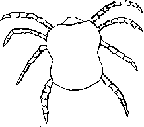 Mites: Mites are the second most common invertebrate found in compost. They have eight leg-like jointed appendages. Some can be seen with the naked eye and others are microscopic. Some can be seen hitching rides on the back of other faster moving invertebrates such as sowbugs, millipedes and beetles. Some scavenge on leaves, rotten wood, and other organic debris. Some species eat fungi, yet others are predators and feed on nematodes, eggs, insect larvae and other mites and springtails. Some are both free living and parasitic. One very common compost mite is globular in appearance, with bristling hairs on its back and red-orange in color.
Mites: Mites are the second most common invertebrate found in compost. They have eight leg-like jointed appendages. Some can be seen with the naked eye and others are microscopic. Some can be seen hitching rides on the back of other faster moving invertebrates such as sowbugs, millipedes and beetles. Some scavenge on leaves, rotten wood, and other organic debris. Some species eat fungi, yet others are predators and feed on nematodes, eggs, insect larvae and other mites and springtails. Some are both free living and parasitic. One very common compost mite is globular in appearance, with bristling hairs on its back and red-orange in color.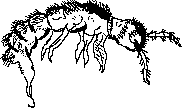 Springtails: Springtails are extremely numerous in compost. They are very small wingless insects and can be distinguished by their ability to jump when disturbed. They run in and around the particles in the compost and have a small spring-like structure under the belly that catapults them into the air when the spring catch is triggered. They chew on decomposing plants, pollen, grains, and fungi. They also eat nematodes and droppings of other arthropods and then meticulously clean themselves after feeding.
Springtails: Springtails are extremely numerous in compost. They are very small wingless insects and can be distinguished by their ability to jump when disturbed. They run in and around the particles in the compost and have a small spring-like structure under the belly that catapults them into the air when the spring catch is triggered. They chew on decomposing plants, pollen, grains, and fungi. They also eat nematodes and droppings of other arthropods and then meticulously clean themselves after feeding. Earthworms: Earthworms do the lion's share of the decomposition work among the larger compost organisms. They are constantly tunneling and feeding on dead plants and decaying insects during the daylight hours. Their tunneling aerates the compost and enables water, nutrients and oxygen to filter down. "As soil or organic matter is passed through an earthworm's digestive system, it is broken up and neutralized by secretions of calcium carbonate from calciferous glands near the worm's gizzard. Once in the gizzard, material is finely ground prior to digestion. Digestive intestinal juices rich in hormones, enzymes, and other fermenting substances continue the breakdown process. The matter passes out of the worm's body in the form of casts, which are the richest and finest quality of all humus material. Fresh casts are markedly higher in bacteria, organic material, and available nitrogen, calcium, magnesium, phosphorus and potassium than soil itself." (Rodale)
Earthworms: Earthworms do the lion's share of the decomposition work among the larger compost organisms. They are constantly tunneling and feeding on dead plants and decaying insects during the daylight hours. Their tunneling aerates the compost and enables water, nutrients and oxygen to filter down. "As soil or organic matter is passed through an earthworm's digestive system, it is broken up and neutralized by secretions of calcium carbonate from calciferous glands near the worm's gizzard. Once in the gizzard, material is finely ground prior to digestion. Digestive intestinal juices rich in hormones, enzymes, and other fermenting substances continue the breakdown process. The matter passes out of the worm's body in the form of casts, which are the richest and finest quality of all humus material. Fresh casts are markedly higher in bacteria, organic material, and available nitrogen, calcium, magnesium, phosphorus and potassium than soil itself." (Rodale)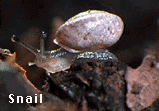 Slugs and snails (left): Slugs and snails generally feed on living plant material but will attack fresh garbage and plant debris and will therefore appear in the compost heap.
Slugs and snails (left): Slugs and snails generally feed on living plant material but will attack fresh garbage and plant debris and will therefore appear in the compost heap.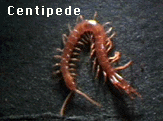 Centipedes (right): Centipedes are fast moving predators found mostly in the top few inches of the compost heap. They have formidable claws behind their head which possess poison glands that paralyze small red worms, insect larvae, newly hatched earthworms, and arthropods - mainly insects and spiders. To view a QuickTime movie of the centipede click on this image
Centipedes (right): Centipedes are fast moving predators found mostly in the top few inches of the compost heap. They have formidable claws behind their head which possess poison glands that paralyze small red worms, insect larvae, newly hatched earthworms, and arthropods - mainly insects and spiders. To view a QuickTime movie of the centipede click on this image Millipedes: They are slower and more cylindrical than centipedes and have two pairs of appendages on each body segment. They feed mainly on decaying plant tissue but will eat insect carcasses and excrement.
Millipedes: They are slower and more cylindrical than centipedes and have two pairs of appendages on each body segment. They feed mainly on decaying plant tissue but will eat insect carcasses and excrement.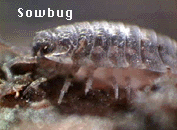 Sow Bugs (right): Sow Bugs are fat bodied crustaceans with delicate plate-like gills along the lower surface of their abdomens which must be kept moist. They move slowly grazing on decaying vegetation.
Sow Bugs (right): Sow Bugs are fat bodied crustaceans with delicate plate-like gills along the lower surface of their abdomens which must be kept moist. They move slowly grazing on decaying vegetation.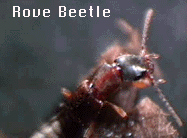 Beetles (left): The most common beetles in compost are the rove beetle, ground beetle and feather-winged beetle. Feather-winged beetles feed on fungal spores, while the larger rove and ground beetles prey on other insects, snails, slugs and other small animals.
Beetles (left): The most common beetles in compost are the rove beetle, ground beetle and feather-winged beetle. Feather-winged beetles feed on fungal spores, while the larger rove and ground beetles prey on other insects, snails, slugs and other small animals.Ants: Ants feed on aphid honey-dew, fungi, seeds, sweets, scraps, other insects and sometimes other ants. Compost provides some of these foods and it also provides shelter for nests and hills. Ants may benefit the compost heap by moving minerals especially phosphorus and potassium around by bringing fungi and other organisms into their nests.
Flies: During the early stages of the composting process, flies provide ideal airborne transportation for bacteria on their way to the pile. Flies spend their larval phase in compost as maggots, which do not survive thermophilic temperatures. Adults feed upon organic vegetation.
Spiders: Spiders feed on insects and other small invertebrates.
 Pseudoscorpions: Pseudoscorpions are predators which seize victims with their visible front claws, then inject poison from glands located at the tips of the claws. Prey include minute nematode worms, mites, larvae, and small earthworms.
Pseudoscorpions: Pseudoscorpions are predators which seize victims with their visible front claws, then inject poison from glands located at the tips of the claws. Prey include minute nematode worms, mites, larvae, and small earthworms.Earwigs: Earwigs are large predators, easily seen with the naked eye. They move about quickly. Some are predators. Others feed chiefly on decayed vegetation.